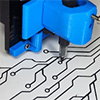Apr 08, 2023 (Nanowerk News) It feels like a classical paradox: How do you see the invisible? But for modern astronomers, it is a very real challenge: How do you measure dark matter, which by definition emits no light? The answer: You see how it impacts things that you can...
How to make electronic noses smell better
Apr 08, 2023 (Nanowerk News) Imagine if you could ask a machine to “smell” something for you with just a click of a button. That’s what electronic noses, or e-noses, are for. They are systems that combine chemical gas sensors, signal processing and machine learning algorithms to mimic the sense...
New printing technique could democratize printed electronics
Apr 08, 2023 (Nanowerk Spotlight) Researchers from the Materials Science Institute of Madrid (part of the Spanish National Research Council), in collaboration with researchers from UNLV, UAM, and KSU universities, have developed a low-cost and simple method for printing electronics using regular pens and a benchtop plotter. This technique allows...
AI-equipped eyeglasses can read silent speech
Apr 06, 2023 (Nanowerk News) Developed by Cornell’s Smart Computer Interfaces for Future Interactions (SciFi) Lab, the low-power, wearable interface requires just a few minutes of user training data before it will recognize commands and can be run on a smartphone, researchers said. Zhang is the lead author of “EchoSpeech:...
Webb reveals never-before-seen details in Cassiopeia A
Apr 07, 2023 (Nanowerk News) The explosion of a star is a dramatic event, but the remains the star leaves behind can be even more dramatic. A new mid-infrared image from NASA’s James Webb Space Telescope provides one stunning example. It shows the supernova remnant Cassiopeia A (Cas A), created...
A new quantum approach to solve electronic structures of complex materials
Apr 07, 2023 (Nanowerk News) If you know the atoms that compose a particular molecule or solid material, the interactions between those atoms can be determined computationally, by solving quantum mechanical equations — at least, if the molecule is small and simple. However, solving these equations, critical for fields from...
Scientists use peroxide to peer into metal oxide reactions
Apr 07, 2023 (Nanowerk News) Researchers at Binghamton University led research partnering with the Center for Functional Nanomaterials (CFN)—a U.S. Department of Energy (DOE) Office of Science User Facility at Brookhaven National Laboratory—to get a better look at how peroxides on the surface of copper oxide promote the oxidation of...
Meta-optics shows physical processes in the attosecond range
Apr 07, 2023 (Nanowerk News) Developed at Harvard, and successfully tested at Graz University of Technology (TU Graz), a revolutionary new meta-optics for microscopes with extremely high spatial and temporal resolution has proven its functional ability in laboratory tests at the Institute of Experimental Physics at TU Graz. Microscopes using...
Simple but revolutionary modular organoids (w/video)
Apr 07, 2023 (Nanowerk News) A team led by Masaya Hagiwara of RIKEN national science institute in Japan has developed an ingenious device, using layers of hydrogels in a cube-like structure, that allows researchers to construct complex 3D organoids without using elaborate techniques. The group also recently demonstrated the ability...
Two-organ chip to answer fatty liver questions
Apr 07, 2023 (Nanowerk News) A new chip that holds different cell types in tiny, interconnected chambers could allow scientists to better understand the physiological and disease interactions between organs. The integrated-gut-liver-on-a-chip (iGLC) platform was designed by scientists at Kyoto University’s Institute for Integrated Cell-Material Sciences (iCeMS), to improve understanding...










